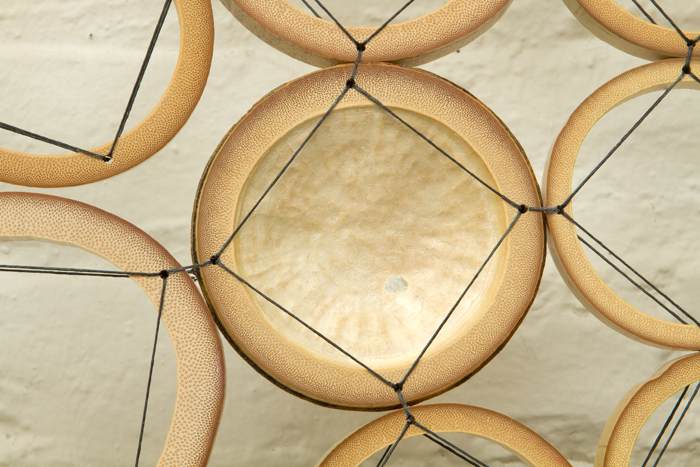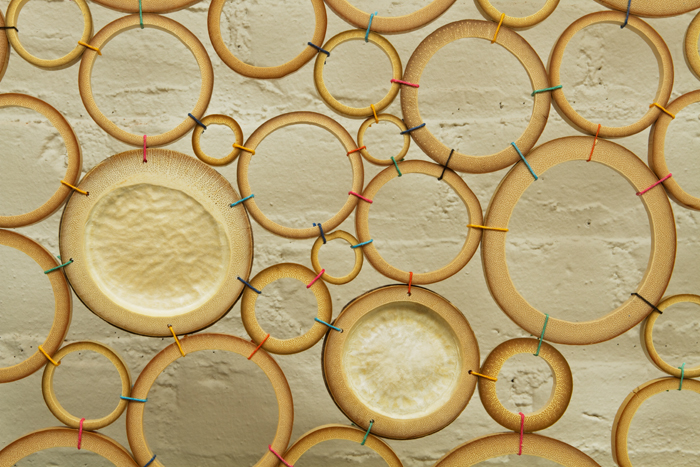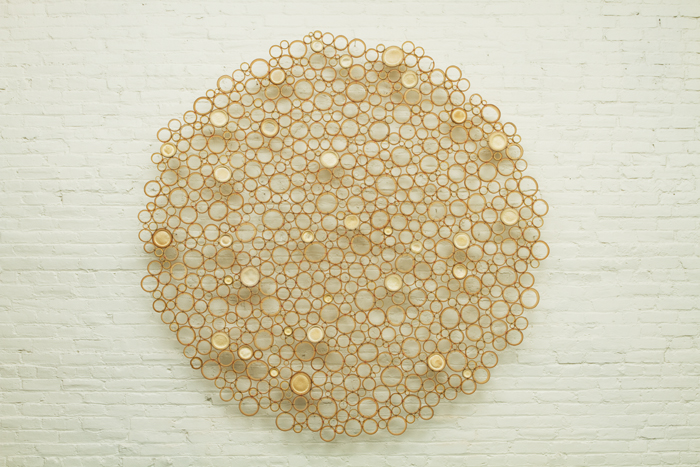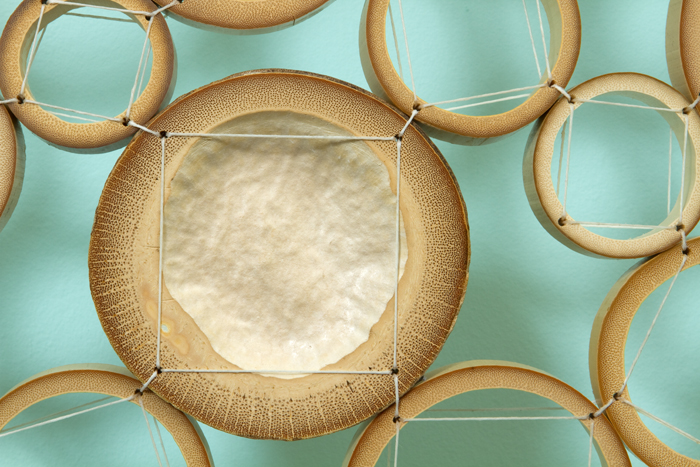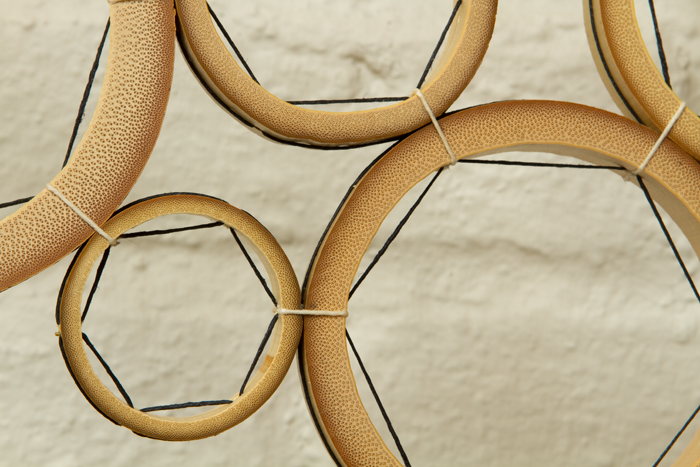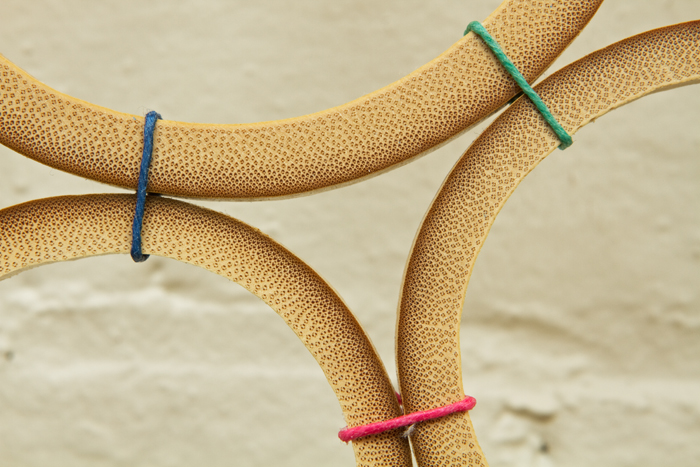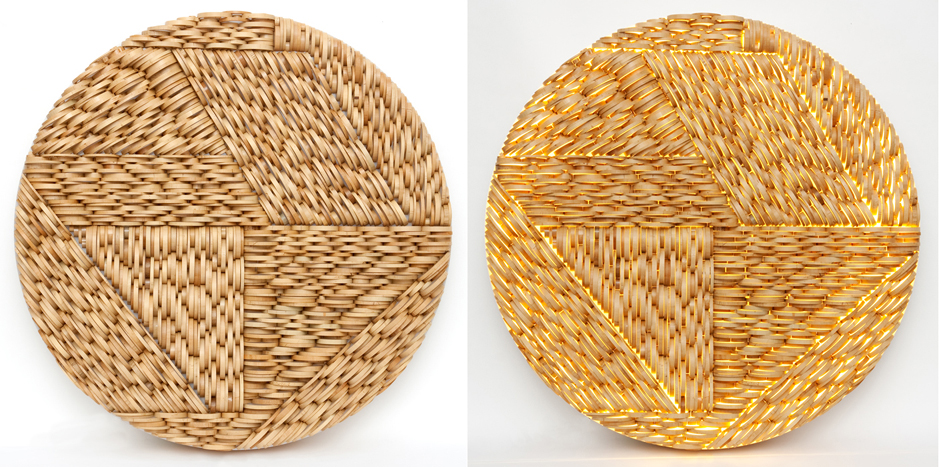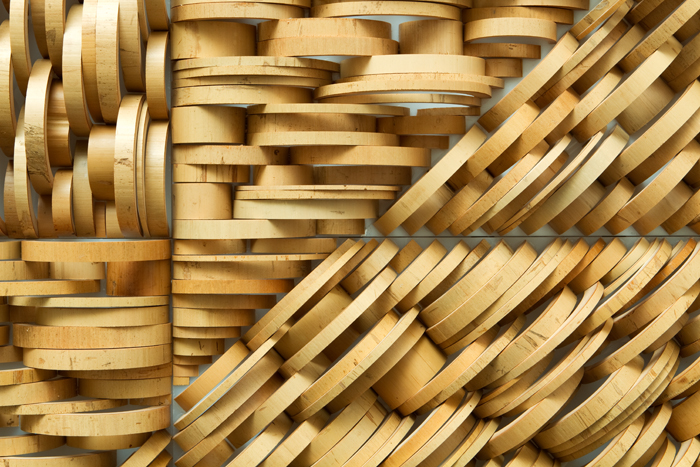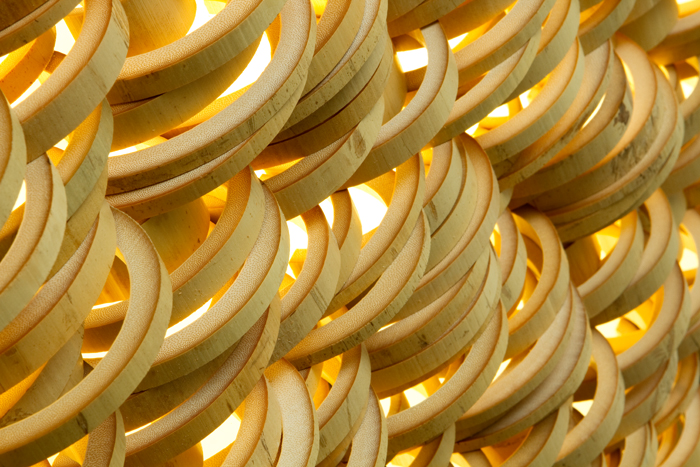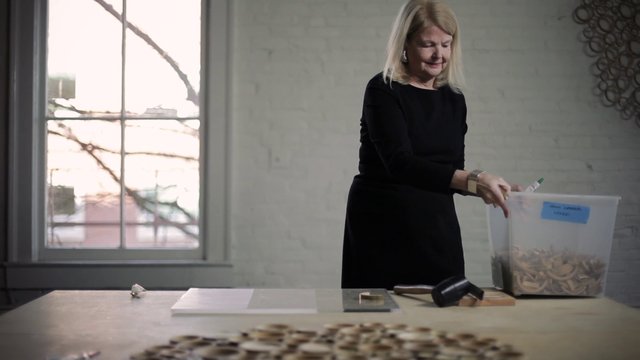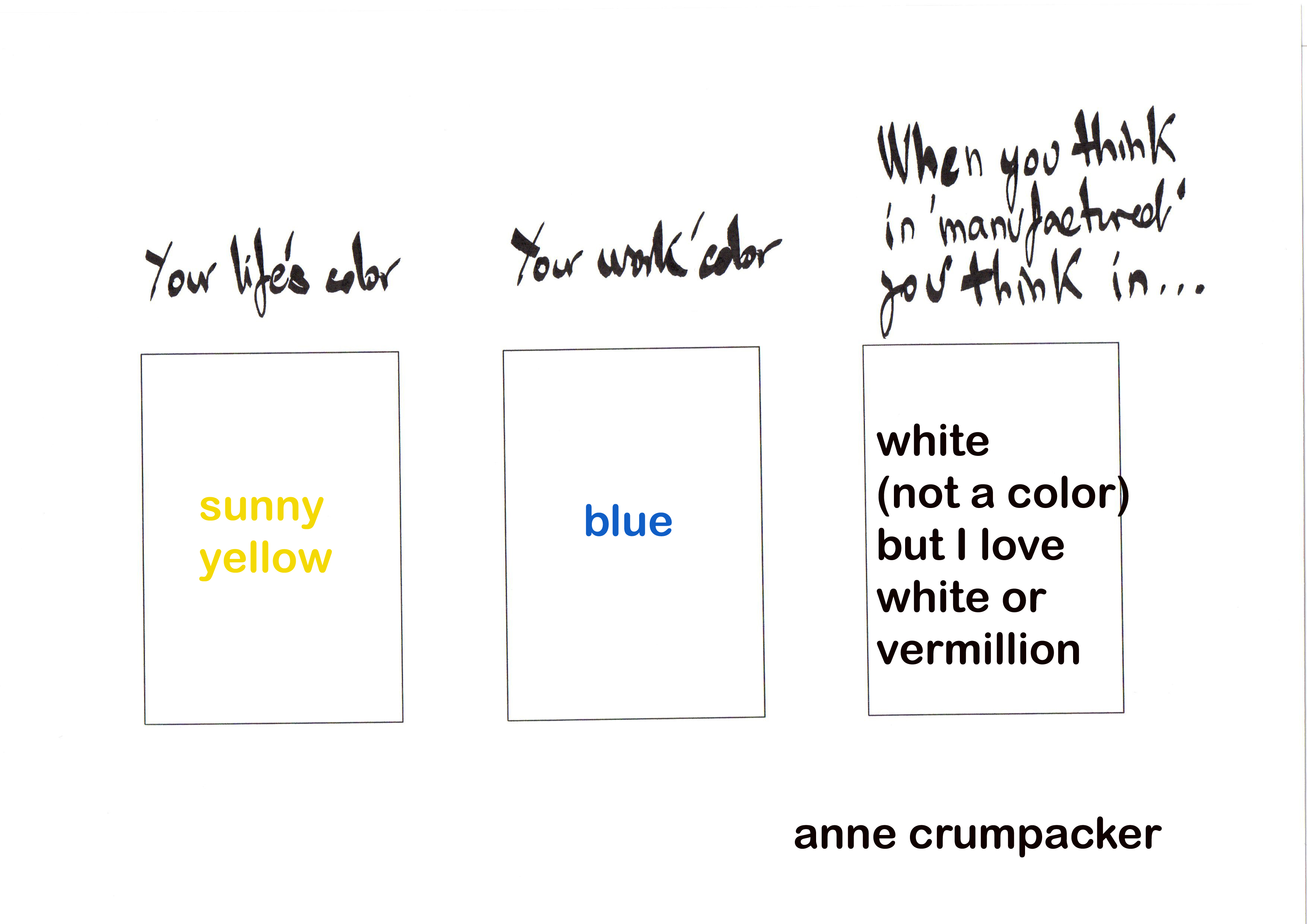mdby……ANNE CRUMPACKER
Here is a great interview ….,) of the wonderful Anne Crumpacker, who is a bamboo artist in Portland, and i have got to admire her through this interview…..have a good friday!!
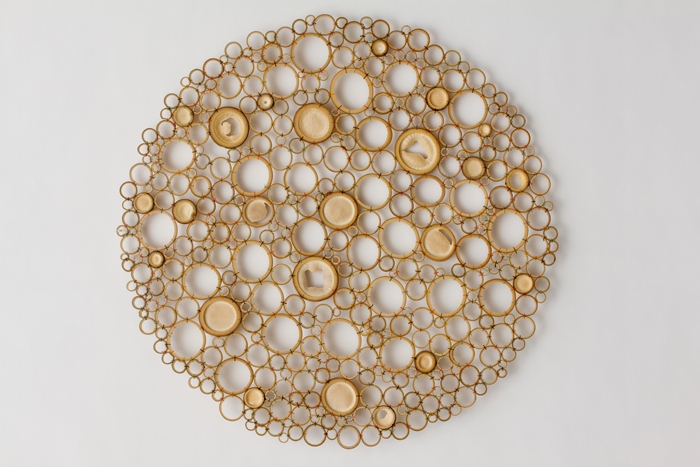
The Bamboo work that you do, is amazing really inspiring, what did you feel when you saw for the first time the monumental bamboo installation created by Hiroshi Teshigahara, to decide to dedicate your life to bamboo?
When I saw the Teshigahara installation, I had a visceral experience and felt a palpable elevation; the sense of deep order and connection one finds in a sanctuary or sacred place. The character of bamboo captivated me for years and I realized that I had a deep connection to it and wanted to understand why it held meaning for my life.
“In art, imagination is determined by the confines one chooses.” (David Mitchell on NPR) I feel as if I can work with bamboo indefinitely and continue to explore unlimited possibilities.
How did you learn the crosscut bamboo technique?
Each student in the MFA ACD (Applied Craft and Design) program works with a mentor once a week during the two years. My first mentor, Charissa Brock, is a bamboo artist and taught me carefully how to use a band saw and chop saw to cut crosscut bamboo. First, a culm of bamboo must be wrapped with masking tape to protect the skin of the bamboo during the cutting process. One can use either a band saw or chop saw, but each requires a special blade (16 teeth to the inch) created specifically to cut bamboo.
You just use, the bamboo slices, placing them in two different ways, looking to their outside skin and creating topographies, or showing its internal cellular composition, what do you feel when you work cutting the bamboo?
The cutting process is labor intensive and hard work. For years, I did all of my own cutting. The most wonderful part of the cutting is to see the random cuts of the nodes and to appreciate the organic shapes which emerge from the cutting process. Now I outsource the cutting to a woodworker so that I can concentrate on the design and creation of the works of art. When I am creating the cross current or topographical work, my attention is totally immersed in gluing the pieces. The hours evaporate. I get into the flow and am amazed at how my hand-eye coordination is in play as my hand intuitively reaches for the appropriate sized piece needed to fit into the sequential space of this gigantic puzzle. I reflect on the minimal design, the simplicity and clarity of express, the close connection to nature through the bamboo, and the serenity and tranquility I experience when working with my hands. I have invented a new approach to using bamboo. Experts have never seen it used this way before.
The same is true when I work with crosscut rings, connecting them with waxed Irish linen thread. Crosscut bamboo exposes the cellular structure of the plant and reveals its inner beauty which I love to see. When I am steeped in the work, boundaries of time and place dissolve. Patterns and rhythms emerge that connect me with the higher creative force.
Do you make a sketch and you know how its artwork it is going to come up, or you just work with the material, joining it until you consider it is finished?
Yes, I do sketching to lay out patterns which are transferred to acrylic for the cross current or topographical designs. The sketches are more or less guidelines and I am always pleasantly surprised to see the finished piece.
The combinations of the crosscut rings are totally random and intuitive. I usually determine the diameter of the “Ensō” or circle and work within the circumference.
Which is process, since you make a first draft, until it is ready to be showed?
The process begins with wrapping the bamboo with masking tape;cutting it; unwrapping the masking tape; waxing each ring; designing the patterns and; having the acrylic cut in the desired shape and light box made for a luminary; installing the LED lights; cutting rings in half for the crosscurrent pattern; gluing to the acrylic; having metal posts made for the connected ring pieces; connecting rings with waxed linen thread; adding nodes with the 3” mounting posts.
You use some color in the joining parts in “Enso” artworks, have you ever thought about giving color to bamboo?
Yes! In graduate school, I stained the bamboo black with a wood dye and it was very effective. Currently, I am painting the crosscut section with black acrylic and will connect the crosscut pieces with vermillion colored, waxed linen thread to create a 42” Ensō. I am looking forward to seeing the impact of the black surface.
What is the meaning of your “writing” artworks, and the different ways you join the slices?
In the “writings” artworks, hundreds of interconnected crosscut sections resemble the microscopic cellular structure of the bamboo and other living organisms. The squares reference grids, overlapping lines, and movement through marks. There is intimacy in the tied knot, showing evidence of the hand.
Do you ever imagine the final client?
Only if I am creating a commission do I imagine the client.
Otherwise, I am in a creative process, following a path of discovery.
How long can it take to make one of your artworks?
As mentioned above, the process is long and labor-intensive. However,
I am immersed in what I am doing and I work meticulously to complete the individual works of art. It takes hours, days, and weeks to complete each work.
You work by your own, is it what you were looking for?
I work primarily on my own. However, I now outsource the cutting of the bamboo to a woodworker. Another woodworker creates the light boxes. A part time assistant helps me with work in the studio. I am problem solving with each of this colleagues.
Tell us, how a normal day in your work is?
I start the day by exercising, walking, etc. I stop at Stumptown Coffee for a latte and then arrive at my studio about 9:30; located in downtown Portland in the historic Skidmore Fountain area; on the third floor in an 1872 building. Three rooms make up my studio: one is where I store the bamboo; the second is where I exhibit the work; and the third is the largest space where I create the art. Natural light floods the space from the East and North. The ceilings are about 20’ high. Arched windows look down and across the waterfront to the Willamette River. I have six work tables so that I can be working on multiple pieces at one time. Or I can put the tables together if the piece is large scale. I usually take a quick lunch break with a sack lunch or I walk a few blocks to the international food carts to get food. I listen to all kinds of music or National Public Radio throughout the day which ends between 4 and 5.
If we are interested about buying one of your artworks, where can we find them? Do you work by commissions?
I sell art work directly to collectors unless my work is on view at a Gallery for a determined length of time. I sign short-term contracts with galleries through which the work is purchased. Yes, I love doing commissions and working with clients, usually for a specific location in a residence. One of the most successful commissions was a 4 foot by 6 foot luminary for a house designed by the Seattle architect, Jim Olson. The commission was site specific; a niche was created during the building process for the luminary; the luminary was recessed a few inches; and the wiring was behind the piece.
What would be your ideal project?
My ideal project would be to design an installation for a gallery or museum space incorporating the various elements of my creative practice to make a profound statement.
What is beauty for you?
To me, beauty is that quality or combination of qualities that brings pleasure to the senses, especially through sight, or by igniting intellectual and/or emotional feelings. I believe that man is born to create and to express beauty, and that the love of beauty is innate. Beauty makes life more vivd, animated, and worth living. It heightens our perception of life around us.
Bamboo’s simple beauty keeps me totally absorbed. I am striving to create works of art that bring pleasure and, I hope, beauty to those who choose to live with them. I find that living with beautiful bamboo objects elevates the spirit by providing serenity, hope, and an expression of harmony between nature and people.
What is the most difficult and the one you like more in your work?
The “writings” is the most complex system I have created and the most challenging and difficult to create. I love working with the crosscut bamboo to create Ensōs with waxed linen thread and the cross current patterns. It is nice to experience different techniques and systems during the day.
Which one has been your biggest success?
I think the greatest success has been “Cross Currents” because this was a completely new expression, unlike anything I had seen previously. I determined that I wanted to interact with the piece on the ground. A culm of square bamboo, 12 feet 8 inches long, and its scale inspired the design of the platform, which is 12 feet 6 inches by 14 feet 6 inches. It is composed of thirteen panels, in square and rectangular shapes. I chose carefully the direction the bamboo was placed, with angles to converge in the center panel that supports the square bamboo. Each panel is covered with the lapped arcs of crosscut bamboo, representing six to eight different diameters and six different widths. When I first reflected on the piece, a reference to waves surfaced, leading to the concept of a river or cross currents, thus the name.
Wave movement, as a source of form, has been an important theme for Japanese artists for centuries. Over the course of their history as island people, they’ve learned to respect waves as one of the strongest forces on earth. I embraced the notion of creating waves from a traditional Japanese material. “Cross Currents” incorporates 20,000 bamboo pieces resembling waves, surrounding a vertical length of square bamboo.
What is your biggest dream for the future?
My biggest dream for the future is to remain healthy so that I can work for the rest of my life in my studio, creating daily. Creating ideas with my hands brings me ultimate pleasure and satisfaction.
Finding a balance between my creative work, my husband, children, grandchildren, friends and the rest of my life is one of the challenges!
Any advice?
It is never too late to start doing. I went to art school and received a MFA in my 60’s! Find time for what you love. Creativity is the ability to imagine what has never existed before. Be open to new possibilities. 80% of success is showing up! The NYC graphic artist, Milton Glazer, said, “Creativity is a verb, a very time-consuming verb and is always going to be a long and difficult process. If you’re doing it right, it’s going to feel like work.” CAVU – Ceiling and visibility unlimited!
And finally….. her own “mdby paper image”….
